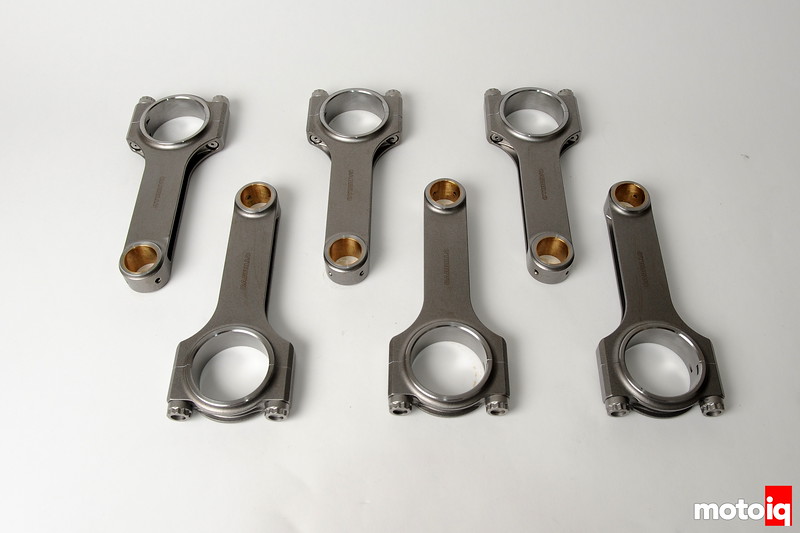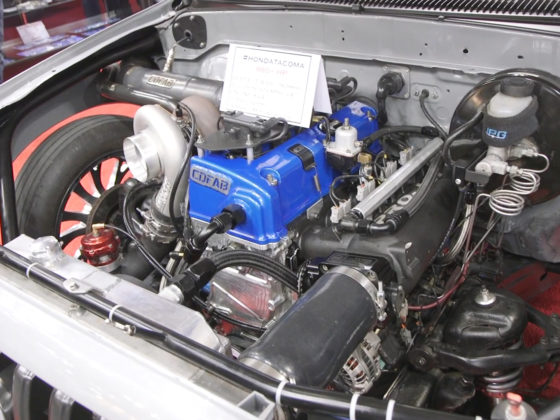 The main and rod bearings, use King’s RadiaLock dimensioning method to get the optimal crush clearance. This helps assure that the bearings will fit tightly in their bore for good heat transfer and good resistance to spinning. Unlike conventional bearings with tight crush, King bearings get clamped tightly in their bores without wear near their parting line due to their dimensioning process.
The main and rod bearings, use King’s RadiaLock dimensioning method to get the optimal crush clearance. This helps assure that the bearings will fit tightly in their bore for good heat transfer and good resistance to spinning. Unlike conventional bearings with tight crush, King bearings get clamped tightly in their bores without wear near their parting line due to their dimensioning process.
 The bearings also use Kings Eccentrix dimensioning method which takes the oil wedge into account when designing in the bearing material thicknesses. The thickness is varied to help form a more stable and consistent hydrodynamic layer of pressurized oil on the bearings face even at high RPM.
The bearings also use Kings Eccentrix dimensioning method which takes the oil wedge into account when designing in the bearing material thicknesses. The thickness is varied to help form a more stable and consistent hydrodynamic layer of pressurized oil on the bearings face even at high RPM.

We used ARP studs for the cylinder heads. The studs replace the stock torque to yield bolts and allow higher torque for increased clamp loads and do not stretch out of shape with each torque down like stock. ARP studs are made of 8740 chromoly steel. 8740 has superior strength over a more common chromoly like 4130 because it has a higher carbon content and responds to heat treatment better. It also makes use of nickel as an alloying element which increases toughness. 8740 has a very high tensile strength of around 200,000 PSI. The ARP studs and bolts also have several design features like rolled (superior to cut threads due to good grain formation in the thread root) asymmetrical J-form threads with more engagement area on the stressed side and a reduced center diameter to reduce stress risers. ARP studs and bolts, when applicable, also have high quality forged nuts and precision ground and hardened washers for accurate torque and positive retention. To avoid distortion of the cylinder tops, we do not exceed the recommended factory torque.

Since our stock crank was destroyed when the rod broke, we replaced it with a new OEM crank. We had the crank balanced and WPC treated it.

The stock oil pan and block were also destroyed by the broken rod and they were replaced with new factory-fresh parts.




10 comments
i had always heard that Nissan engines, particularly the RBs, were underpowered in comparison to how robust they were. Those days, apparently, are long gone when we get 500+ HP out of bolt-on upgrades.
Any downsides to the narrow rod bearings?
Less surface area to maintain the oil film so less pressure needed before getting bearing wear. Good oil flow and pressure can somewhat mitigate it.
Very nice article, really accessible, will there be updates?
Also, I couldn’t help wonder, was there any discussion about the downpipes getting coated? Did any other goodies get thrown in “since you were in there anyway?”
Been a reader since SCC and still miss that magazine!
Other than the PC9 coating on the pistons, the parts were kept mostly stock. This was a customer car and they just wanted their car back. Though it may not seem like a lot was done, the total gets up there pretty quick thanks to the GT-R tax.
Great write up guys. Just to add some context:
The original motor was stock with about 90k mi on it, most of which was spent with the boost up for WOT on E85. It was not in fact bad gas that lead to failure but rather an accidental downshift at WOT which resulted in a low RPM load on the OEM rods. If that had not happened, my guess is the engine would still be alive. That tune had a reduction in torque as mentioned in the article. But even with the motor build, that mistake should not be repeated. if you have a GTR – don’t let that happen!
The owner just dynod the new setup and the results were impressive with the stock turbos. The head work appears to have netted a consistent gain in TQ across the rev range; but more impressively the peak TQ RMP was lowered by over 700 RPM’s down to 3,500 RPM’s.
Great build guys. Hi Howard, Mike and Martin.
I’ve really loved all of these modification articles / videos on the project GT-R. I was wondering if you would be making a video comparing the modified car’s performance to a stock car? Maybe quarter mile, 0-62, and a few laps on a track or Auto-X?
I think it would be really great to have some sort of benchmarking so that owners will know how the mods improve the car in more sure terms.
Thanks,
The car came here with a windowed block so no before!
could you be so kind to share you piston to wall clearance along with main and rod bearing clearance. this seems to be a very secretive issue when it comes to building a vr38 motor for about 1200hp or so.
We don’t give that information away either. Its part of our engine building service.